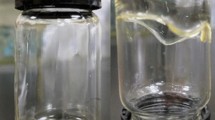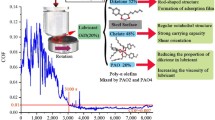Abstract
Lubricating oil additives based on boron compounds are promising materials for lubrication due to their tribological advantages such as antiwear efficiency, good film strength, and high temperature resistance. This article deals with the preparation of zinc borate particles that are well dispersed and colloidally stabilized in mineral oil. This method starts with preparing two inverse emulsions (water-in-oil) with sorbitan monostearate (Span 60) as a surfactant, light neutral oil as a continuous phase, and the aqueous solutions of borax decahydrate (Na2B4O7·10H2O) and zinc nitrate (Zn(NO3)2·6H2O) as the dispersed phases. The produced particles were zinc borate crystals having both rod-like and spherical morphologies, and the diameters of spherical particles were changing between 20 and 30 nm. FTIR spectra of the obtained particles showed the characteristic peaks of trihedral borate (B(3)-O) and tetrahedral borate (B(4)-O) groups as well as the specific peaks of the sorbitan monostearate. TG showed 30.42% and 22.08% mass loss at 600 °C for the samples prepared by inverse emulsion and precipitation techniques, respectively. The endothermic peak at 50 °C is observed due to the melting of sorbitan monostearate and the heat of melting is evaluated as −3.50 J/g. Tribological studies revealed that sorbitan monostearate not only outperformed as a dispersing agent of inorganic particles, but also it proved to be an anti-wear agent. Zinc borate produced by precipitation decreased the wear scar diameter from 1.402 to 0.639 mm and the friction coefficient from 0.099 to 0.064. The inverse emulsion was effective in decreasing wear scar diameter and the friction coefficient by lowering them to 0.596 and 0.089 mm, respectively.








Similar content being viewed by others
References
Tian Y, He Y, Yu L, Deng Y, Zheng Y, Sun F, Liu Z, Wang Z. In situ and one-step synthesis of hydrophobic zinc borate nanoplatelets. Colloids Surf A. 2008;312:99–103.
Köytepe S, Vural S, Seçkin T. Molecular design of nanometric zinc borate-containing polyimide as a route to flame retardant materials. Mater Res Bull. 2009;44:369–76.
Dong JX, Hu ZS. A study of the anti-wear and friction-reducing properties of the lubricant additive, nanometer zinc borate. Tribol Int. 1998;3:219–23.
Eltepe HE, Balköse D, Ülkü S. Effect of temperature and time on zinc borate species formed from zinc oxide and boric acid in aqueous medium. Ind Eng Chem Res. 2007;46:2367–71.
Erdoğdu CA, Atakul S, Balköse D, Ülkü S. Development of synergistic heat stabilizers for PVC from zinc borate–zinc phosphate. Chem Eng Commun. 2009;196:148–60.
Capek I. Preparation of metal nanoparticles in water-in-oil (w/o) microemulsions. Adv Colloid Interface Sci. 2004;110:49–74.
Shi J, Weweij H. Synthesis and purification of oxide nanoparticle dispersions by modified emulsion precipitation. Langmiur. 2005;2:5570–5.
Yu Z, Sun Y, Wei W, Lu L, Wang X. Preparation of NdCrO3 nanoparticles and their catalytic activity in the thermal decomposition of ammonium perchlorate by DSC/TG–MS. J Therm Anal Calorim. 2009;97:903–9.
Bakunin VN, Suslov Ay, Kuzmina GN, Prenago OP. Synthesis and application of inorganic nanoparticles as lubricant components–a review. J Nanopart Res. 2004;6:273–84.
Tai CY, Chen CK. Particle morphology, habit, and size control of CaCO3 using reverse microemulsion technique. Chem Eng Sci. 2008;63:3632–42.
Sharma BK, Rashid U, Anwar F, Erhan SZ. Lubricant properties of Moringa oil using thermal and tribological techniques. J Therm Anal Calorim. 2009;96:999–1008.
Hu ZS, Lai R, Lou F, Wang LG, Chen ZL, Chen GX, Dong JX. Preparation and tribological properties of nanometer magnesium borate as lubricating oil additive. Wear. 2001;252:370–4.
Hu ZS, Dong JX. Study on antiwear and reducing friction additive of nanometer titanium borate. Wear. 1998;216:87–91.
Hu ZS, Dong JX, Chen GX, He JZ. Preparation and tribological properties of nanoparticle lanthanum borate. Wear. 2000;243:43–7.
Wasilewski T, Sulek MW. Paraffin oil solutions of the mixture of sorbitan monolaurate–ethoxylated sorbitan monolaurate as lubricants. Wear. 2006;261:230–4.
Hu ZS, Dong JX, Chen GX. Replacing solvent drying technique for nanometer particle preparation. J Colloid Interface Sci. 1998;208:367–72.
Goa YH, Liu ZH, Wang XL. Hydrothermal synthesis and thermodynamic properties of 2ZnO·3B2O3·3H2O. J Chem Thermodyn. 2009;41:775–8.
Jun L, Shupping X, Shiyang G. FT-IR and raman spectroscopic study of hydrated borates. Spectrochim Acta A Mol Biomol Spectrosc. 1995;51:519–32.
Acknowledgements
The authors acknowledge the financial support from The Scientific and Technical Research Council of Turkey (TÜBİTAK) (project number: 105M358), OPET Petrolcülük A.Ş. for providing tribological properties of zinc borate lubricants and Izmir Institute of Technology, Biotechnology and Bioengineering Central Research Laboratories for the optical microscopy studies.
Author information
Authors and Affiliations
Corresponding author
Rights and permissions
About this article
Cite this article
Savrık, S.A., Balköse, D. & Ülkü, S. Synthesis of zinc borate by inverse emulsion technique for lubrication. J Therm Anal Calorim 104, 605–612 (2011). https://doi.org/10.1007/s10973-010-1159-0
Received:
Accepted:
Published:
Issue Date:
DOI: https://doi.org/10.1007/s10973-010-1159-0




